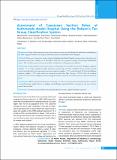Please use this identifier to cite or link to this item:
https://hdl.handle.net/20.500.14356/1352| Title: | Assessment of Caesarean Section Rates at Kathmandu Model Hospital Using the Robson’s Ten Group Classification System |
| Authors: | Poudel, Rekha Dangal, Ganesh Karki, Aruna Pradhan, Hema Kumari Shrestha, Ranjana Bhattachan, Kabin Bajracharya, Nishma Tiwari, Kenusha Devi Bharti, Sonu |
| Citation: | PoudelR., DangalG., KarkiA., PradhanH. K., ShresthaR., BhattachanK., BajracharyaN., TiwariK. D., & BhartiS. (2020). Assessment of Caesarean Section Rates at Kathmandu Model Hospital Using the Robson’s Ten Group Classification System. Journal of Nepal Health Research Council, 17(4), 491-494. https://doi.org/10.33314/jnhrc.v17i4.2117 |
| Issue Date: | 2019 |
| Publisher: | Nepal Health Research Council |
| Article Type: | Original Article |
| Keywords: | Caesarean section Robson ten group classification system vaginal birth after caesarean |
| Series/Report no.: | Oct-Dec, 2019;2117 |
| Abstract: | Abstract Background: Aims of this study was to assess the caesarean section rate and identify the indications contributing to the same using the Robson’s Ten Group Classification System at Kathmandu Model Hospital. Methods: This was a retrospective study conducted at Kathmandu Model Hospital among women who underwent caesarean section from 1 January to 31 December, 2018 and were grouped according to Ten Group Classification System. The overall caesarean section rate and the contribution of each group was calculated. Results: The overall caesarean section rate was 66.1% (494 among 747 total deliveries) in 2018. Nullipara, singleton cephalic, >= 37 weeks, spontaneous labor (Group 1) was the major (24.2%) contributor to the overall caesarean section rate followed by previous caesarean section, singleton cephalic, >=37 weeks (Group 5, 22.6%) and nullipara, singleton cephalic, >=37 weeks, induced or caesarean section before labor (Group 2, 18.8%). Also, the caesarean section rate was 49.5% in nullipara, thus increasing the trend of caesarean section for previous caesarean section in future. Conclusions: Efforts must be focused more on Group 1, 2 and 5 to decrease the increasing trend of caesarean section Promoting vaginal delivery in nullipara and facilitating vaginal birth after caesarean are the most relevant areas of intervention. Keywords: Caesarean section; Robson ten group classification system; vaginal birth after caesarean. |
| Description: | Original Article |
| URI: | http://103.69.126.140:8080/handle/20.500.14356/1352 |
| ISSN: | Print ISSN: 1727-5482; Online ISSN: 1999-6217 |
| Appears in Collections: | Vol. 17 No. 4 Issue 45 Oct-Dec 2019 |
Files in This Item:
| File | Description | Size | Format | |
|---|---|---|---|---|
| 2117-Manuscript-13234-1-10-20200121.pdf | Fulltext Download | 630.01 kB | Adobe PDF |  View/Open |
Items in DSpace are protected by copyright, with all rights reserved, unless otherwise indicated.
